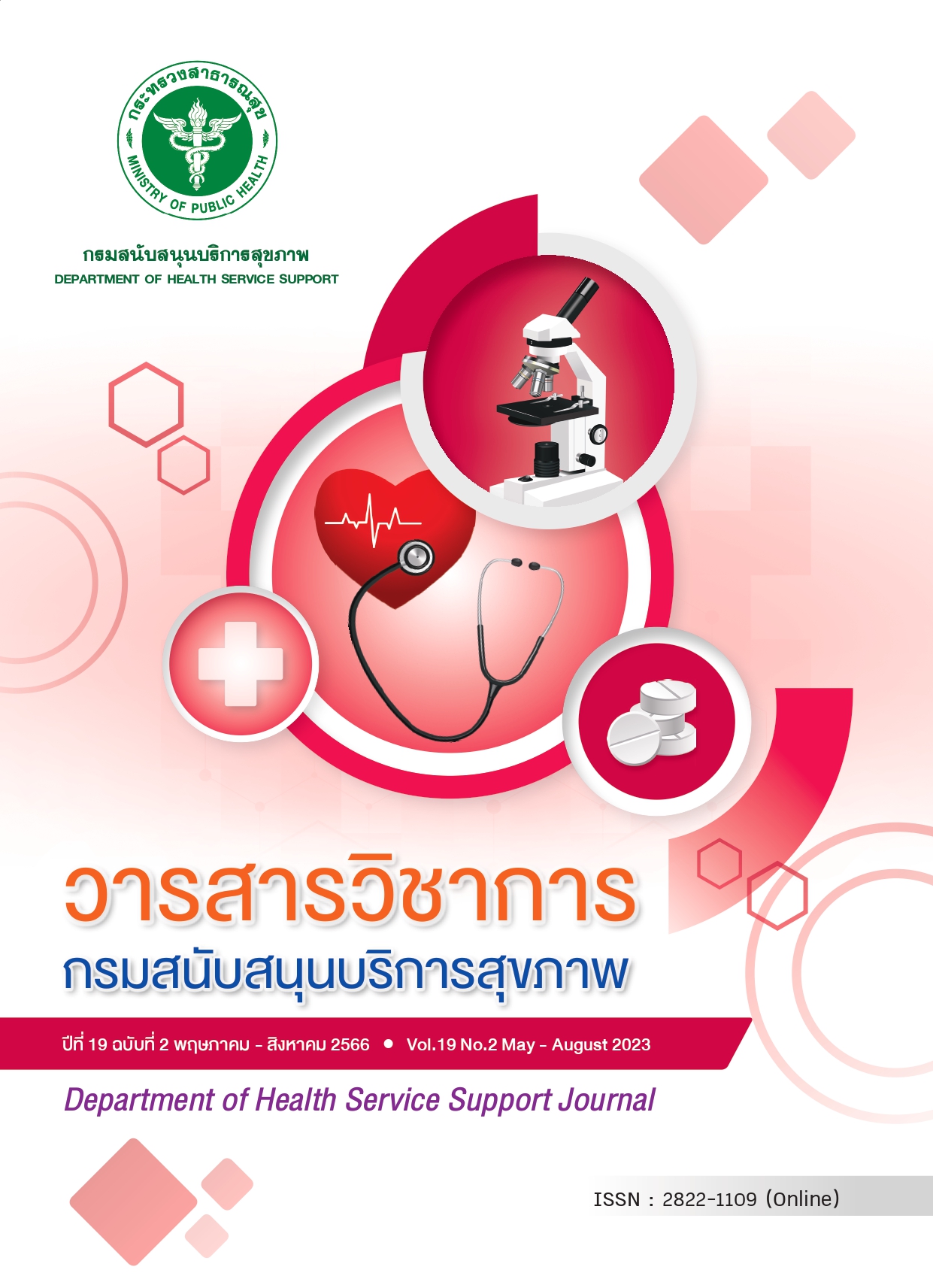การประเมินความครอบคลุมอย่างมีประสิทธิผลของรูปแบบ การจัดบริการโรคสมาธิสั้นในเด็กและวัยรุ่นในพื้นที่อำเภอหนองฮี จังหวัดร้อยเอ็ด
คำสำคัญ:
โรคสมาธิสั้น, ความครอบคลุมอย่างมีประสิทธิผล, ผลสัมฤทธิ์ของระบบบริการสุขภาพบทคัดย่อ
การวิจัยนี้เป็นการศึกษาเชิงปริมาณ แบบย้อนหลังจากผลลัพธ์สุขภาพ ซึ่งเป็นการประเมินผลสัมฤทธิ์ของระบบ บริการสุขภาพโรงพยาบาลหนองฮี เป็นการศึกษาความครอบคลุมอย่างมีประสิทธิผลของรูปแบบการจัดบริการโรคสมาธิสั้น ในเด็กและวัยรุ่นอายุ 6-17 ปี พื้นที่อำเภอหนองฮี จังหวัดร้อยเอ็ด ศึกษาใน 3 มิติ คือ มิติความจำเป็นด้านสุขภาพ มิติการใช้ บริการ และมิติประสิทธิผลของการบริการ ซึ่งแบ่งออกเป็น 2 ด้าน ได้แก่ ประสิทธิผลทางคลินิก และประสิทธิผลด้านความ สามารถ ซึ่งทำการศึกษาเด็กและเยาวชน จำนวน 175 คน ที่ได้รับการวินิจฉัยโรคสมาธิสั้น โดยใช้แบบประเมินคัดกรอง ภาวะโรคสมาธิสั้น และแบบประเมินพฤติกรรมของผู้ป่วยสมาธิสั้น และแบบบันทึกผลการเรียน เก็บข้อมูลผลการบำบัด รักษาระหว่างเดือนมิถุนายน 2562 – มีนาคม 2563 วิเคราะห์ข้อมูลโดยใช้สถิติพรรณนา จำนวน และร้อยละ
ผลการศึกษา พบว่า ความต้องการทางสุขภาพของการจัดบริการบำบัดรักษาโรคสมาธิสั้นในเด็กและวัยรุ่น เท่ากับ ร้อยละ 8.74 การได้รับบริการสุขภาพตามความจำเป็น เท่ากับร้อยละ 100 แต่พบอัตราการเข้ารับการบบัดรักษาลดลง ระยะ 3 เดือน คงเหลือ ร้อยละ 94.85 ระยะ 6 เดือน คงเหลือ ร้อยละ 85.71 และ เมื่อครบ 1 ปี คงเหลือ ร้อยละ 84.57 ประสิทธิผลการรักษาทางคลินิก พบว่า เมื่อรักษาครบ 1 ปี กลุ่มที่มีอาการขาดสมาธิลดลงเหลือ ร้อยละ 8.78 (จากก่อนการ รักษา ร้อยละ 100) อาการอยู่ไม่นิ่ง หุนหันพลันแล่นคงเหลือร้อยละ 6.08 (จากก่อนรับการรักษา ร้อยละ 38.28) และ ผลสัมฤทธิ์ทางการศึกษา พบว่า ระดับเกรดเฉลี่ย เพิ่มสูงอยู่ในระดับ มากกว่า 3–4 ร้อยละ 34.46 (จากเดิมก่อนการบำบัด รักษา ร้อยละ 5.71)
การศึกษานี้ให้ข้อเสนอแนะว่า ควรมีการพัฒนาระบบบริการด้านการติดตามผลการรักษาต่อเนื่อง ระบบการส่งต่อข้อมูล ระบบการเฝ้าระวัง และการวิจัยพัฒนารูปแบบการบำบัดรักษาทางเลือกต่างๆ รวมถึงปัจจัยด้านบริบทครอบครัวและชุมชน ในการสนับสนุนการบำบัดรักษาเด็กและวัยรุ่นโรคสมาธิสั้นให้มีประสิทธิภาพเพิ่มมากขึ้น
เอกสารอ้างอิง
Boonsith. Withharn. (2012). Attention Deficit Hyperactivity Disorder: Diagnosis and Treatment. Journal of the Psychiatric Association of Thailand. 57(4) 373-386. (In Thai).
Chaiudomsom, Channarong. et al. (2018). Study on the effectiveness of family empowerment programs and School for Behavior Adjustment of School-aged Children with Behavioral Problems Resource Deficient Areas. Northeastern Institute of Child and Adolescent Mental Health, Department of Mental Health, Ministry of public health. (in Thai).
Chalothorn, Prawee. et al. (2019). Prevalence of ADHD among parents of ADHD children admitted to Siriraj Hospital. Public Health Journal. 49(1). (in Thai)
Christopher Murray and David Evans. (2003). Health Systems Performance Assessment : Debate, Methods and Empiricism. WHO. Geneva.
Darasit, Chaiwat. (2019). The development of an integrated care system for children with ADHD by parents.Medical personnel and teachers, Nam Yuen District, Ubon Ratchathani Province.System Research and Development Journal Health. 2019; 12(1). (in Thai).
Dan Sai Hospital and the Research Office for the Development of Thai Health Security (NHSO). (2018). Project to assess the effective coverage of preventive services. control and treat diabetes A case study of Somdej Phra Yuparaj Hospital, Dansai Dan Sai District, Loei Province. Public Health Systems Research Institute. Nonthaburi. (in Thai).
Department of Mental Health, Ministry of Public Health. (2014) Guidelines for the care of psychiatric diseases in children and adolescents 4 major diseases. (cognitive impairment, autism, ADHD, LD) for the Public Health Service Network. 1st print:Printing House of the Agricultural Cooperative Association of Thailand Limited. (in Thai).
Jitnuam, Patchaporn. (2021). Behavioral and academic outcomes of treating ADHD children in Bangchak Hospital Samut Prakan. Samut Prakan: Bangchak Hospital. (in Thai).
Ketuman, Phanom. et al. (2016). Study of the prevalence of attention deficit hyperactivity disorder and related factors among adolescents in the primary care center. Children and youth of the Mercy House. Journal of the Psychiatric Association of Thailand. 2016.61(1): 27-39. (in Thai).
Khamduang, Nucharee. (2017). Handbook of drug treatment in ADHD children and monitoring of drug response in children. Rajanagarindra Institute of Child Development. 1st edition. Chiang Mai: Siam Print Nana Co., Ltd. (in Thai).
Northeastern Institute of Child and Adolescent Mental Health Department of Mental Health. (2016). Government service National Award. Service Development Excellence Award category. (in Thai).
Pengchai, Jatuporn. et al. (2012). Screening and providing assistance to students who are at risk of becoming special children. Elementary school of Si Sawat Wittaya Municipality School. Rajabhat University Journal Maha Sarakham; V. Mor. 2012; 6(1): 15-52. (in Thai).
Pittayaratsathien, Nattorn. et al. (2014). Properties of the Swanson ADHD screening form, Nolan, and Pelham IV Scale (SNAP-IV) and Strengths and Difficulties Questionnaire Section related to restless behavior/attention deficit hyperactivity disorder (SDQ-ADHD), Thai version. Journal of the Psychiatric Association of Thailand. 2014; 59(2): 97-110. (in Thai).
Saksaktawee, Burachat. et al. (2019). A Transverse Analytical Study of Factors Affecting Attention Deficit Hyperactivity Disorder (ADHD). in school-aged children who received outpatient services in a child psychiatric clinic Sichon Hospital. Academic journal Physician District 11, 2019. 33(2): 327-338. (in Thai).
Saksiriphon, Daranee. (2013). A study of attention deficits in children with learning disabilities in the district.Bangkok.Srinakharinwirot University. (in Thai).
Sirithongthaworn, Samai. et al. (2017). The development of an integrated care model for children with ADHD between Medical personnel, parents and teachers in the northern region. Department of Mental Health, Rajanagarindra Institute of Child Development in cooperation with the Faculty of Pharmacy Chiang Mai University. (in Thai).
Wirakul, Chiranun . (2014). Attention deficit hyperactivity disorder and hyperactivity in children. Buddha Chinnarat Medical Journal. 2014; 31(1):65-75. (in Thai).
Witsanuyothin, Taweesin. (2013). Prevalence of attention deficit hyperactivity disorder in Thailand. Royal Institute of Child and Adolescent Mental Health Nakarin, Department of Mental Health, Ministry of Public Health. (in Thai).
Witthayaphipopsakul, Woranan. et al. (2022). Effective coverage and its application in the Thai context. Journal of Public Health Systems Research. 2022; 16(1):112-27. (in Thai).
ดาวน์โหลด
เผยแพร่แล้ว
วิธีการอ้างอิง
ฉบับ
บท
การอนุญาต
ลิขสิทธิ์ (c) 2023 วารสารวิชาการกรมสนับสนุนบริการสุขภาพ

This work is licensed under a Creative Commons Attribution-NonCommercial-NoDerivatives 4.0 International License.



